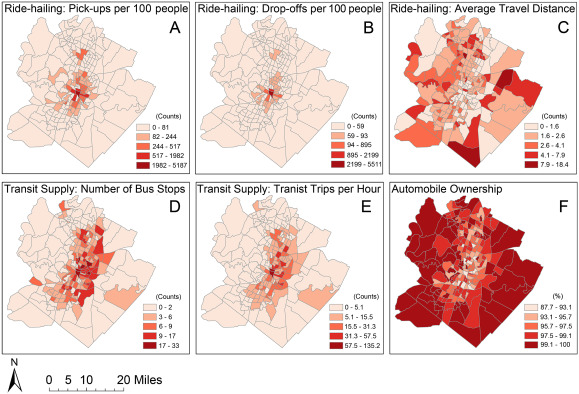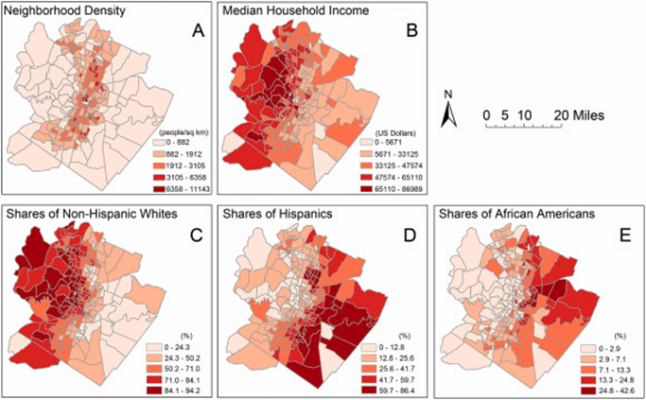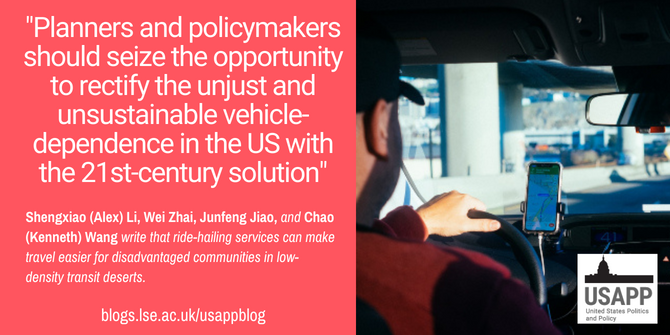


 Ride-hailing services are often seen as benefiting the middle classes and other well-off Americans. But can they also serve people living in low-density areas, especially those who do not own vehicles? In new research, Shengxiao (Alex) Li, Wei Zhai, Junfeng Jiao, and Chao (Kenneth) Wang examined how ride-hailing services have reshaped transportation across neighborhoods in Austin, Texas. They find that while ride-hailing services mainly serve those who live downtown, where transit services are available, they also have the potential to help people living in low-income and low-density neighborhoods, and those without vehicles.
Ride-hailing services are often seen as benefiting the middle classes and other well-off Americans. But can they also serve people living in low-density areas, especially those who do not own vehicles? In new research, Shengxiao (Alex) Li, Wei Zhai, Junfeng Jiao, and Chao (Kenneth) Wang examined how ride-hailing services have reshaped transportation across neighborhoods in Austin, Texas. They find that while ride-hailing services mainly serve those who live downtown, where transit services are available, they also have the potential to help people living in low-income and low-density neighborhoods, and those without vehicles.
Ride-hailing services like Uber and Lyft have reshaped transportation in cities and communities across the US. On the one hand, they provide flexible, affordable, and convenient services for those without vehicles, and for those who find it difficult to park in cities. On the other, they can replace transit services in some places and times of day.
These services have great potential to ease transportation problems in low-density areas. In many western and southern US cities built after the automobile age, vehicle-dependence is universal. Unlike transit-rich cities such as New York City, Chicago, Philadelphia, or San Francisco, in most western and southern middle- and small-sized cities, not having a vehicle can limit people’s daily travel to their jobs, grocery stores, healthcare facilities, and daycare centers. Ride-hailing is more crucial in these areas as they have redefined car access and provide alternatives for people who have difficulties owning, maintaining vehicles, or driving.
Unfortunately, current research on ride-hailing and its relationship with existing private and public transportation systems is mainly concentrated in large cities. Studies in middle- and small-sized vehicle-dependent cities are rare. Our research uses multiple data sources in Austin, Texas to investigate how ride-hailing services influence the transportation resources in different neighborhoods and for different groups of people.
Transit services in Austin
Austin developed during the automobile age, growing from a population of 22,000 in 1900 to nearly 660,000 in 2000, and depends heavily on daily travel vehicles (Figure 1). The transit supply is concentrated in the downtown, while the majority of transit-dependent people, especially the low-income Hispanic population, are located in “transit deserts” outside the downtown (Figure 2).
Figure 1 – Transportation resources in different neighborhoods of Austin, Texas

Figure 2 – Density and socioeconomic attributes of Austin’s neighborhoods

Austin developed a uniform ride-hailing platform in 2016, RideAustin, which aims to provide affordable ride-hailing services for everyone in the city. RideAustin provides ride-hailing services with lower prices than Uber and Lyft, and affordable rides for marginalised people, especially low-income people and older adults, to hospitals and other destinations. However, the ride-hailing services mainly concentrate downtown, aligned with areas with rich transit services.
Ride hailing can help in transport planning for low income communities
Can ride-hailing services reduce travel difficulties for people living in disadvantaged and low-density communities and, especially, for people without vehicles in low-density areas? Our work combines census data, ride-hailing user GPS big data, transportation network data, and ride-hailing survey data to find the answer. We find that ride-hailing journeys are less likely to begin or end in low-density and low-income neighborhoods compared to their high-density and high-income counterparts. Ride-hailing users without private vehicles are more likely to be racial and ethnic minorities or younger people with higher education. Ride-hailing services provide people with a convenient and safe transportation mode, irrespective of their vehicle ownership. While ride-hailing users with vehicles had more positive attitudes about its convenience compared to public transit, those without vehicles applauded ride-hailing for its relative affordability.

Photo by Paul Hanaoka on Unsplash
Our study sheds light on future transportation planning in a ride-hailing era in low-density areas. Given the potential of ride-hailing services in addressing transport equity in a vehicle-dependent world, local governments should work with non-profit agencies and private sectors to improve the accessibility of ride-hailing services for people with low incomes and less education. In particular, actions should be made to reduce the costs of using ride-hailing services. Ride-hailing providers should also learn more about users’ technology literacy and needs, and provide non-smartphone equivalents for people in low-density areas to use their services. For example, GoGoGrandparent is a hotline-based service developed to help older adults who do not have smartphones to hail rides through their land-line phones.
Ride-hailing services can also encourage public transit development in low-density areas. As public transportation planning in the low-density areas is neither cost-effective nor efficient in low-density areas, ride-hailing services have a great deal of room to connect with on-demand public transit systems and provide door-to-door transportation services for all. The US Congress recently approved the Infrastructure Investment and Jobs Act which provides many opportunities to bring on-demand, innovative transportation solutions to low-density areas. Planners and policymakers should seize the opportunity to rectify the unjust and unsustainable vehicle-dependence in the US with the 21st-century solution, with the goal of providing accessibility to various destinations for all.
- This article is based on the paper ‘Who loses and who wins in the ride-hailing era? A case study of Austin, Texas’, in Transport Policy.
Please read our comments policy before commenting.
Note: This article gives the views of the author, and not the position of USAPP– American Politics and Policy, nor of the London School of Economics.
Shortened URL for this post: https://bit.ly/3xPV9Zw
About the authors
 Shengxiao (Alex) Li – University of Pennsylvania
Shengxiao (Alex) Li – University of Pennsylvania
Shengxiao (Alex) Li recently received his PhD in City and Regional Planning from the University of Pennsylvania. His research focuses on the interaction of land use, transportation, and technology, how these aspects can advance people’s capability in accessing daily activities and quality of life, and the policy implications to improve access for all. His recent research mainly focuses on such topics related to older adults, and has been published on top transportation and planning journals, including Journal of American Planning Association, Journal of Planning Literature, and Transportation Research Part A.
 Wei Zhai – Hong Kong Baptist University
Wei Zhai – Hong Kong Baptist University
Wei Zhai is an Assistant Professor in the Department of Geography at Hong Kong Baptist University. His research focuses on urban resilience, urban data science and GeoAI. His research has been published on top geography and planning journals, including Journal of Planning Education and Research, Urban Studies, and Annals of the American Association of Geographers.
 Junfeng Jiao – The University of Texas at Austin
Junfeng Jiao – The University of Texas at Austin
Junfeng Jiao is an associate professor in the Community and Regional Planning program at The University of Texas at Austin. He is the founding director of Urban Information Lab, Co-Director of Texas Smart Cities and a founding member of UT Good Systems Grand Challenge. His research focuses on Smart City, Smart Transportation, Urban Informatics and Ethical AI. He has published two books in Shared Mobility and Smart Cities.
 Chao (Kenneth) Wang – Harvard University
Chao (Kenneth) Wang – Harvard University
Chao (Kenneth) Wang is an incoming master’s student in Data Science at Harvard University who has recently graduated from University College London as an undergraduate in statistics. He is a member of British Mensa. His research interest includes the scalable applications of machine learning and deep learning.



